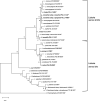Listeria cossartiae sp. nov., Listeria farberi sp. nov., Listeria immobilis sp. nov., Listeria portnoyi sp. nov. and Listeria rustica sp. nov., isolated from agricultural water and natural environments
- PMID: 33999788
- PMCID: PMC8289207
- DOI: 10.1099/ijsem.0.004795
Listeria cossartiae sp. nov., Listeria farberi sp. nov., Listeria immobilis sp. nov., Listeria portnoyi sp. nov. and Listeria rustica sp. nov., isolated from agricultural water and natural environments
Erratum in
-
Corrigendum: Listeria cossartiae sp. nov., Listeria farberi sp. nov., Listeria immobilis sp. nov., Listeria portnoyi sp. nov. and Listeria rustica sp. nov., isolated from agricultural water and natural environments.Int J Syst Evol Microbiol. 2021 Jun;71(6):004885. doi: 10.1099/ijsem.0.004885. Int J Syst Evol Microbiol. 2021. PMID: 34181516 Free PMC article. No abstract available.
Abstract
A total of 27 Listeria isolates that could not be classified to the species level were obtained from soil samples from different locations in the contiguous United States and an agricultural water sample from New York. Whole-genome sequence-based average nucleotide identity blast (ANIb) showed that the 27 isolates form five distinct clusters; for each cluster, all draft genomes showed ANI values of <95 % similarity to each other and any currently described Listeria species, indicating that each cluster represents a novel species. Of the five novel species, three cluster with the Listeria sensu stricto clade and two cluster with sensu lato. One of the novel sensu stricto species, designated L. cossartiae sp. nov., contains two subclusters with an average ANI similarity of 94.9%, which were designated as subspecies. The proposed three novel sensu stricto species (including two subspecies) are Listeria farberi sp. nov. (type strain FSL L7-0091T=CCUG 74668T=LMG 31917T; maximum ANI 91.9 % to L. innocua), Listeria immobilis sp. nov. (type strain FSL L7-1519T=CCUG 74666T=LMG 31920T; maximum ANI 87.4 % to L. ivanovii subsp. londoniensis) and Listeria cossartiae sp. nov. [subsp. cossartiae (type strain FSL L7-1447T=CCUG 74667T=LMG 31919T; maximum ANI 93.4 % to L. marthii) and subsp. cayugensis (type strain FSL L7-0993T=CCUG 74670T=LMG 31918T; maximum ANI 94.7 % to L. marthii). The two proposed novel sensu lato species are Listeria portnoyi sp. nov. (type strain FSL L7-1582T=CCUG 74671T=LMG 31921T; maximum ANI value of 88.9 % to L. cornellensis and 89.2 % to L. newyorkensis) and Listeria rustica sp. nov. (type strain FSL W9-0585T=CCUG 74665T=LMG 31922T; maximum ANI value of 88.7 % to L. cornellensis and 88.9 % to L. newyorkensis). L. immobilis is the first sensu stricto species isolated to date that is non-motile. All five of the novel species are non-haemolytic and negative for phosphatidylinositol-specific phospholipase C activity; the draft genomes lack the virulence genes found in Listeria pathogenicity island 1 (LIPI-1), and the internalin genes inlA and inlB, indicating that they are non-pathogenic.
Keywords: ANI; GTDB-Tk; Listeria sensu lato; Listeria sensu stricto; novel species.
Conflict of interest statement
The authors declare there are no conflicts of interest.
Figures



Similar articles
-
Listeria floridensis sp. nov., Listeria aquatica sp. nov., Listeria cornellensis sp. nov., Listeria riparia sp. nov. and Listeria grandensis sp. nov., from agricultural and natural environments.Int J Syst Evol Microbiol. 2014 Jun;64(Pt 6):1882-1889. doi: 10.1099/ijs.0.052720-0. Epub 2014 Mar 5. Int J Syst Evol Microbiol. 2014. PMID: 24599893
-
Soil Collected in the Great Smoky Mountains National Park Yielded a Novel Listeria sensu stricto Species, L. swaminathanii.Microbiol Spectr. 2022 Jun 29;10(3):e0044222. doi: 10.1128/spectrum.00442-22. Epub 2022 Jun 6. Microbiol Spectr. 2022. PMID: 35658601 Free PMC article.
-
Listeria booriae sp. nov. and Listeria newyorkensis sp. nov., from food processing environments in the USA.Int J Syst Evol Microbiol. 2015 Jan;65(Pt 1):286-292. doi: 10.1099/ijs.0.070839-0. Epub 2014 Oct 23. Int J Syst Evol Microbiol. 2015. PMID: 25342111
-
Listeria marthii sp. nov., isolated from the natural environment, Finger Lakes National Forest.Int J Syst Evol Microbiol. 2010 Jun;60(Pt 6):1280-1288. doi: 10.1099/ijs.0.014118-0. Epub 2009 Aug 10. Int J Syst Evol Microbiol. 2010. PMID: 19667380
-
Proposal of Lactobacillus kosoi Chiou et al. 2018 as a later heterotypic synonym of Lactobacillus micheneri McFrederick et al. 2018, elevation of Lactobacillus plantarum subsp. argentoratensis to the species level as Lactobacillus argentoratensis sp. nov., and Lactobacillus zhaodongensis sp. nov., isolated from traditional Chinese pickle and the intestinal tract of a honey bee (Apis mellifera).Int J Syst Evol Microbiol. 2020 May;70(5):3123-3133. doi: 10.1099/ijsem.0.004141. Int J Syst Evol Microbiol. 2020. PMID: 32250238
Cited by
-
Duplex real-time PCR assay with high-resolution melt analysis for the detection and quantification of Listeria species and Listeria monocytogenes in meat products.J Food Sci Technol. 2023 May;60(5):1541-1550. doi: 10.1007/s13197-023-05695-2. Epub 2023 Mar 1. J Food Sci Technol. 2023. PMID: 37033312 Free PMC article.
-
High-throughput homogenous assay for the direct detection of Listeria monocytogenes DNA.Sci Rep. 2024 Mar 25;14(1):7026. doi: 10.1038/s41598-024-56911-8. Sci Rep. 2024. PMID: 38528005 Free PMC article.
-
Distribution and phenotypic and genotypic characterization of Listeria monocytogenes isolated from food, Colombia, 2010-2018.Biomedica. 2021 Oct 15;41(Sp. 2):165-179. doi: 10.7705/biomedica.6152. Biomedica. 2021. PMID: 34669287 Free PMC article. English, Spanish.
-
Listeriosis: Characteristics, Occurrence in Domestic Animals, Public Health Significance, Surveillance and Control.Microorganisms. 2024 Oct 12;12(10):2055. doi: 10.3390/microorganisms12102055. Microorganisms. 2024. PMID: 39458364 Free PMC article. Review.
-
Minimum Inhibitory Concentration (MIC) and Minimum Bactericidal Concentration (MBC) for Twelve Antimicrobials (Biocides and Antibiotics) in Eight Strains of Listeria monocytogenes.Biology (Basel). 2021 Dec 29;11(1):46. doi: 10.3390/biology11010046. Biology (Basel). 2021. PMID: 35053044 Free PMC article.
References
-
- Seeliger HP. [Nonpathogenic listeriae: L. innocua sp. n. (Seeliger et Schoofs, 1977) (author's transl)] Zentralbl Bakteriol Mikrobiol Hyg A. 1981;249:487–493. - PubMed
-
- Seeliger HP, Rocourt J, Schrettenbrunner A, Grimont P, Jones D. Listeria ivanovii sp. nov. Int J Syst Evol Microbiol. 1984;34:336–337.
-
- Boerlin P, Rocourt J, Grimont F, Grimont PA, Jacquet C, et al. Listeria ivanovii subsp. londoniensis subsp. nov. Int J Syst Evol Microbiol. 1992;42:69–73.
-
- Rocourt J, Grimont P. Notes: Listeria welshimeri sp. nov. and Listeria seeligeri sp. nov. Int J Syst Bacteriol. 1983;33:866–869. doi: 10.1099/00207713-33-4-866. - DOI
MeSH terms
Substances
Grants and funding
LinkOut - more resources
Full Text Sources
Other Literature Sources
Molecular Biology Databases
Research Materials

